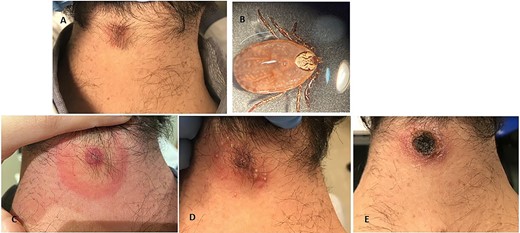-
PDF
- Split View
-
Views
-
Cite
Cite
Francesca F Norman, Jesús Sánchez-Martín, Mario Rodríguez-Domínguez, Raquel Escudero, Oihane Martín, Dermacentor-borne necrosis erythema lymphadenopathy (DEBONEL) due to Rickettsia raoultii in a patient with erythema migrans, Journal of Travel Medicine, Volume 30, Issue 8, December 2023, taad057, https://doi.org/10.1093/jtm/taad057
Close - Share Icon Share
A previously healthy 41-year-old Spanish male was referred with a skin lesion on the posterior scalp region and right lateral cervical lymphadenopathy, with no additional symptoms, 96 hours following tick removal (Figure 1, identified as Dermacentor marginatus). He had been picking mushrooms in a mountainous area to the North of Madrid 11 days before. A full blood count and serum biochemistry were normal.
Dermacentor-borne necrosis erythema lymphadenopathy (DEBONEL) was suspected and doxycycline 100-mg bid was initiated. On day 2 of treatment, the cutaneous lesion evolved and resembled erythema migrans (see Figure 1) and a diffuse tenuous rash appeared on the back, although the patient remained afebrile. On day 5, the exanthem appeared to be resolving and only an eschar of the cervical region remained. The patient completed a 14-day course of doxycycline with complete resolution of symptoms.

(A) Day 1 of symptoms: cutaneous lesion and right lateral cervical lymphadenopathy; (B) adult female Dermacentor marginatus removed from posterior neck area; (C) Day 2 of symptoms: erythema migrans-like lesion; (D) Day 5 of symptoms: neck eschar; (E) Day 12 of symptoms: necrotic eschar.
Borrelia spp. and Rickettsia conorii serology on days 1, day 18 and day 75 of the illness remained negative. Rickettsia spp and Borrelia spp PCR in blood (taken on day 5 of treatment with doxycycline) were negative. PCR performed in the tick at the National Referral Centre for Microbiology was positive for R. raoultii and negative for Borrelia spp.
DEBONEL, TIBOLA (tick-borne lymphadenopathy) and SENLAT (scalp-eschar-and-neck-lymphadenopathy after tick bite) are terms used to describe localized diseases, usually caused by various Rickettsia species, following a tick bite. The most widely known acronym is TIBOLA, describing only adenopathy without describing an eschar, retrieving over 2780 articles in PubMED (https://pubmed.ncbi.nlm.nih.gov), followed by DEBONEL (under 40 articles), describing infections transmitted by Dermacentor spp. ticks only and SENLAT (under 25 articles), which presents in a clinically similar way but may also be transmitted by Ixodes spp. or by Rhipicephalus spp.1 DEBONEL describes the current clinical case best and refers to the vector species involved. Experts have called for consensus as the different terminology may lead to confusion.2 Ricksetta raoultii has been identified less frequently as an etiologic agent in this geographical area. A recent review of over 200 cases of DEBONEL in the North of Spain reported detection of Candidatus Rickettsia rioja, Rickettsia slovaca, R. raoultii and Rickettsia DmS1 genotype in 91, 66, 4 and 3 patients, respectively.2
Although erythema migrans is usually associated with infections or co-infections with Borrelia spp., this cutaneous lesion has also been reported following tick bites in patients with no evidence of Lyme Disease and the possible role of tick salivary toxins has been raised.3 Both DEBONEL and Borrelia spp. infections may be initially treated with doxycycline pending the diagnostic work-up. Although TIBOLA/DEBONEL usually responds well to short course therapy, the correct identification of the aetiology and ruling out possible co-infections with Borrelia spp would be relevant, given the potential for chronic disease and complications associated with the latter. Rickettsia spp and Borrelia spp co-infections in Dermacentor spp. in Spain have been described, although other studies question the role of this tick species in the transmission of spirochaetes to susceptible hosts.4,5 Seroconversion may be delayed/absent or may not be detected if the available serology is not Rickettsia species-specific and, as in this case, PCR in a cutaneous biopsy or in the tick may assist in the definitive diagnosis.
CRediT authors statement
Francesca Norman (Conceptualization-Equal, Formal analysis-Equal, Writing—original draft-Lead), Jesús Sánchez-Martín (Data curation-Supporting, Writing—review and editing-Supporting), Mario Rodriguez-Dominguez (Writing—review and editing-Supporting), Raquel Escudero (Formal analysis-Supporting, Writing—review and editing-Supporting), Oihane Martín (Formal analysis-Supporting, Writing—review and editing-Supporting).
Funding
This research was supported by CIBER—Consorcio Centro de Investigación Biomédica en Red (CB 2021), Instituto de Salud Carlos III, Ministerio de Ciencia e Innovación and Unión Europea—NextGenerationEU.
Author contributions
All authors contributed to the clinical management of the patient and interpretation of the data. F.F.N. wrote the paper, and the co-authors reviewed the final draft.
Conflict of interest statement
None declared.
Grant Support
None



